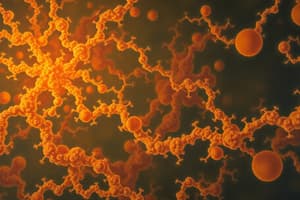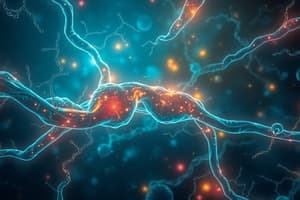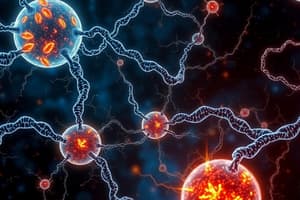Podcast
Questions and Answers
What are the two metabolic states the body experiences?
What are the two metabolic states the body experiences?
- Anabolic and Catabolic
- Synthesis and Breakdown
- Fed and Fasted
- Absorptive and Post-Absorptive (correct)
What process occurs when glucose supplies exceed the demand for ATP?
What process occurs when glucose supplies exceed the demand for ATP?
- Glycolysis
- Glycogenesis (correct)
- Glycogenolysis
- Gluconeogenesis
Which organ is primarily responsible for gluconeogenesis during the post-absorptive state?
Which organ is primarily responsible for gluconeogenesis during the post-absorptive state?
- Pancreas
- Kidneys
- Liver (correct)
- Skeletal Muscle
Which of the following best describes glycogenolysis?
Which of the following best describes glycogenolysis?
What is the main purpose of glycogenolysis in muscle during the post-absorptive state?
What is the main purpose of glycogenolysis in muscle during the post-absorptive state?
Which statement about gluconeogenesis is correct?
Which statement about gluconeogenesis is correct?
What are fatty acids primarily broken down into during beta-oxidation?
What are fatty acids primarily broken down into during beta-oxidation?
In which organ does gluconeogenesis primarily occur?
In which organ does gluconeogenesis primarily occur?
What substance does the liver acquire during the post-absorptive state to maintain blood glucose levels?
What substance does the liver acquire during the post-absorptive state to maintain blood glucose levels?
What is the primary characteristic of the post-absorptive state?
What is the primary characteristic of the post-absorptive state?
What triggers the process of glycogenesis?
What triggers the process of glycogenesis?
What is the first step in glycogenesis?
What is the first step in glycogenesis?
Which process involves the conversion of non-carbohydrate precursors into glucose?
Which process involves the conversion of non-carbohydrate precursors into glucose?
Which of the following statements is incorrect regarding glycogen metabolism?
Which of the following statements is incorrect regarding glycogen metabolism?
What is one of the key goals of the post-absorptive mechanisms?
What is one of the key goals of the post-absorptive mechanisms?
Which of the following is NOT a process involved in carbohydrate metabolism?
Which of the following is NOT a process involved in carbohydrate metabolism?
What role does insulin play in relation to glucose transport into target cells?
What role does insulin play in relation to glucose transport into target cells?
What physiological condition leads to the inhibition of insulin secretion?
What physiological condition leads to the inhibition of insulin secretion?
Which of the following neurotransmitters is involved in stimulating insulin secretion?
Which of the following neurotransmitters is involved in stimulating insulin secretion?
What is the effect of abnormally elevated plasma glucose concentration?
What is the effect of abnormally elevated plasma glucose concentration?
Which condition is characterized by the absence of insulin production?
Which condition is characterized by the absence of insulin production?
What type of protein primarily transports substances in the body?
What type of protein primarily transports substances in the body?
What is the main function of defensive proteins?
What is the main function of defensive proteins?
What change occurs to lipoproteins as triglycerides are released?
What change occurs to lipoproteins as triglycerides are released?
What percentage of a cell's mass is primarily made up of proteins?
What percentage of a cell's mass is primarily made up of proteins?
What primarily characterizes lipemia in blood plasma?
What primarily characterizes lipemia in blood plasma?
Where is adipose tissue NOT typically stored?
Where is adipose tissue NOT typically stored?
During which developmental stages does the rate of anabolism exceed catabolism?
During which developmental stages does the rate of anabolism exceed catabolism?
What is the main function of LDL?
What is the main function of LDL?
What is NOT a function of proteins in the body?
What is NOT a function of proteins in the body?
What role do HDL lipoproteins play in cholesterol metabolism?
What role do HDL lipoproteins play in cholesterol metabolism?
What type of R-group contains amino acids like G, A, V, L, M, P, and W?
What type of R-group contains amino acids like G, A, V, L, M, P, and W?
Which amino acids are classified as acidic due to their R-group containing a carboxyl group?
Which amino acids are classified as acidic due to their R-group containing a carboxyl group?
What describes the tertiary structure of proteins?
What describes the tertiary structure of proteins?
What role do motor proteins play in cellular functions?
What role do motor proteins play in cellular functions?
Which of the following correctly identifies how basic R-groups function?
Which of the following correctly identifies how basic R-groups function?
Flashcards are hidden until you start studying
Study Notes
Carbohydrate Processes
- Glycogenesis - polymerizes glucose to form glycogen in the liver and skeletal muscle.
- Occurs when glucose supply exceeds ATP demand.
- Glucose is covalently bonded to form glycogen stores.
- High ATP levels turn off glycolysis which allows for the formation of glycogen.
- Formula: Glucose - Glucose 6 Phosphate - Glucose 1 Phosphate – Glycogen
- Glycogenolysis - hydrolyzes glycogen into glucose monomers in the liver and skeletal muscle.
- Stimulated by low blood glucose levels.
- Formula: Glycogen splits into Glucose 1 Phosphate - Glucose 6 Phosphate - Glucose.
- Glucose is then used for energy.
- Hepatocytes act as enzymes, converting Glucose 6 Phosphate to Glucose to allow diffusion into the bloodstream.
- Gluconeogenesis - forms glucose from noncarbohydrate precursors in the liver.
- Occurs when dietary sources and glucose reserves are depleted.
- Glucose is made from amino acids and glycerol.
- Protects the nervous system against hypoglycemia by ensuring ongoing ATP synthesis.
- Glucose uptake by brain cells is continuous while uptake by other body cells is regulated by insulin.
Lipid Processes
- Triglyceride absorption - chylomicrons transport triglycerides (fats) from the small intestine.
- Chylomicrons are synthesized in intestinal epithelial cells.
- The number of adipocytes remains constant except before puberty in children.
- Lipemia is the presence of excess chylomicrons in blood plasma, giving it a milky appearance after a fatty meal.
- Muscle cells and adipocytes remove triglycerides from chylomicrons in the bloodstream for 4-6 hours.
- Adipose tissue is stored in subcutaneous areas, around kidneys and heart, within the abdomen, and in the breasts, hips, and buttocks.
- VLDL (very low-density lipoproteins) - formed when chylomicron remnants enter the liver and combine with proteins and synthesized triglycerides from lipogenesis.
- VLDL are released back into the blood.
- As triglycerides are released, the density of lipoproteins increases and VLDL transform into LDL.
- LDL (low-density lipoproteins) - mainly contain cholesterol and are taken up by cells through receptor-mediated endocytosis.
- HDL (high-density lipoproteins) - produced and released by the liver.
- They pick up excess cholesterol and phospholipids from tissues and transport them to the liver.
Protein Processes
- Deamination - amino acids are converted into keto acids in the liver.
- Ammonia is produced as a byproduct and converted to urea in the liver to be excreted by the kidneys.
- Keto acids enter the citric acid cycle for energy production.
- Excess amino acids are used for cellular respiration, but they must be modified in the liver first.
- Other protein functions:
- Structural integrity of muscles, tendons, and ligaments.
- Enzymatic activity.
- Hormonal regulation.
- Neurotransmitter synthesis.
- Cell receptors.
- Antibodies and cell membrane transport proteins.
Metabolic Balance
- Catabolism - breakdown of complex molecules into simpler ones, releasing energy (fueling cellular respiration).
- Anabolism - synthesis of complex molecules from simpler ones, requiring energy.
- The rate of anabolism exceeds catabolism during embryonic and fetal development, infancy, and childhood to support growth and development.
- An excess of anabolic processes over catabolism leads to weight gain.
- Nutrient pools - the body's current stock of available amino acids, carbs, and lipids.
- The body manages these pools to maintain an adequate supply of nutrients for anabolic processes and energy.
- Organs involved in managing nutrient pools:
- Liver: stores glycogen and performs key metabolic reactions.
- Adipose tissue: stores triglycerides.
- Skeletal muscle: stores glycogen and is abundant in protein.
Metabolic States
- Absorptive (fed state) - nutrients enter the bloodstream from the GI tract during and shortly after eating.
- Post-absorptive (fasted state) - the GI tract is empty and energy is supplied by the breakdown of body reserves.
- The body must maintain an adequate nutrient supply regardless of whether it is in a fed or a fasted state.
Post-Absorptive (Fasted) State
- Post- absorptive state goals:
- Maintain blood glucose levels within a normal range.
- Provide energy to the brain and other tissues.
- Preserve lean body mass.
- What happens at the end of the absorptive state:
- GI tract is empty.
- Blood glucose levels begin to decline.
- Hormonal changes occur (insulin secretion decreases, glucagon secretion increases).
- Carb metabolism:
- Glycogenolysis in the liver releases glucose into the bloodstream.
- Lipid metabolism:
- Lipolysis in adipose tissue releases free fatty acids and glycerol into the bloodstream.
- Protein metabolism:
- Protein breakdown increases, supplying amino acids for gluconeogenesis.
- Post-absorptive state processes (catabolic):
- Glycogenolysis - breakdown of glycogen in the liver.
- Glucose is released into the blood to maintain normal blood glucose levels.
- Glycogenolysis in muscle - glycogen breakdown in muscle.
- Glucose-6-phosphate is used for cellular respiration directly in muscle.
- Pyruvate or lactate is released into the blood for the liver to convert into glucose if needed.
- Lipolysis/mobilization/β-oxidation - breakdown of triglycerides in adipose tissue.
- Free fatty acids and glycerol are released.
- Fatty acids are transported to tissues for energy.
- The glycerol is used for gluconeogenesis in the liver.
- Gluconeogenesis - formation of glucose from noncarbohydrate precursors.
- Amino acids and glycerol are used as sources.
- Occurs mainly in the liver to maintain blood glucose levels.
- Ketogenesis - formation of ketone bodies from fatty acids.
- Occurs in the liver when glucose levels are low.
- Ketone bodies can be used as fuel by the brain.
- Protein breakdown - increasing protein catabolism to provide amino acids for gluconeogenesis and energy production.
- Glycogenolysis - breakdown of glycogen in the liver.
Insulin’s Mechanism of Action
- Target cells: liver, muscle cells, and adipose tissue.
- Insulin stimulates the insertion of GLUT-4 transporter proteins into the cell membrane, allowing glucose to enter cells.
- Insulin binding to receptors on target cells stimulates:
- Glucose uptake.
- Glycogenesis.
- Protein synthesis.
- Lipid synthesis.
- GLUT-4 transporters:
- Insulin-sensitive glucose transporter proteins.
- Responsible for glucose uptake in muscle and adipose tissue.
- Insulin stimulates the translocation of GLUT-4 from intracellular vesicles to the cell membrane.
Insulin Secretion
- Stimulated by:
- Increased blood glucose levels.
- Parasympathetic stimulation of the GI tract and pancreas.
- Amino acids in the bloodstream.
- Amplified by:
- Gastrointestinal hormones (like gastrin, secretin, GIP).
- Inhibited by:
- Stress hormones (epinephrine, norepinephrine, cortisol).
- Reduced blood glucose levels.
Glucagon Secretion
- Stimulated by:
- Decreased blood glucose levels.
- Increased levels of amino acids.
- Factors that influence the stimulus for glucagon secretion:
- Duration of fasting.
- Dietary intake of protein.
- Physical activity.
- Abnormally elevated plasma glucose concentration is called hyperglycemia.
- Causes of hyperglycemia:
- Diabetes mellitus.
- Excess intake of carbohydrates.
- Certain medications.
Type 1 Diabetes
- Type 1 diabetes:
- Autoimmune disease that destroys beta cells in the pancreas.
- Results in an absolute deficiency of insulin.
- Causes:
- Genetic predisposition.
- Environmental triggers.
- Symptoms:
- Increased thirst and urination.
- Excessive hunger.
- Weight loss.
- Fatigue.
- Blurred vision.
- Slow-healing wounds.
- Increased infections.
- Treatments:
- Insulin therapy.
- Blood glucose monitoring.
- Healthy diet and exercise.
Type 2 Diabetes
- Type 2 diabetes:
- Characterized by insulin resistance.
- The pancreas produces insulin, but the body's cells are unable to respond to it properly.
- Causes:
- Genetic predisposition.
- Obesity.
- Lack of physical activity.
- Aging.
- Complications:
- Heart disease.
- Stroke.
- Kidney disease.
- Nerve damage.
- Retinopathy (eye damage).
- Amputations.
- Treatment:
- Lifestyle modifications (diet, exercise, weight loss).
- Oral medications.
- Insulin therapy (in some cases).
Protein and Nucleic Acids
- Protein - consists of one or more polypeptide chains folded and coiled into a specific shape (conformation).
- Makes up 50% of a cell's mass.
- Functions:
- Enzymatic reactions.
- Storage of amino acids.
- Protection against disease.
- Transport of substances.
- Other protein functions:
- Hormonal regulation - insulin.
- Receptors - nerve cells.
- Movement - cilia, flagella, muscle contraction.
- Structural support- hair, skin appendages, connective tissue.
- Amino acids - building blocks of proteins.
- Contain: Carbon, hydrogen, oxygen, nitrogen, and a variable R-group.
- Buffering capacities: act as buffers to maintain pH stability.
- R-groups - provide unique properties to amino acids.
- Types:
- Non-polar: hydrophobic, repel water (glycine, alanine, valine, leucine, isoleucine, methionine, proline, tryptophan).
- Polar: hydrophilic, attract water (serine, threonine, cysteine, tyrosine, asparagine, glutamine).
- Electrically charged:
- Acidic: carboxyl group in their R-group, release H+ (aspartic acid, glutamic acid).
- Basic: nitrogen in their R-group, accept H+ (lysine, arginine, histidine).
- Types:
- Hydrophobic interactions (-) - interactions between nonpolar R-groups.
- Stabilize protein structure by pushing nonpolar R-groups together in the interior of the protein.
- Polypeptides - chains of amino acids connected by peptide bonds.
- Levels of protein structure:
- Primary: sequence of amino acids.
- Secondary: folding of the polypeptide chain into alpha-helices or beta-sheets.
- Tertiary: 3D shape of the polypeptide chain.
- Quaternary: arrangement of multiple polypeptide chains.
Studying That Suits You
Use AI to generate personalized quizzes and flashcards to suit your learning preferences.




